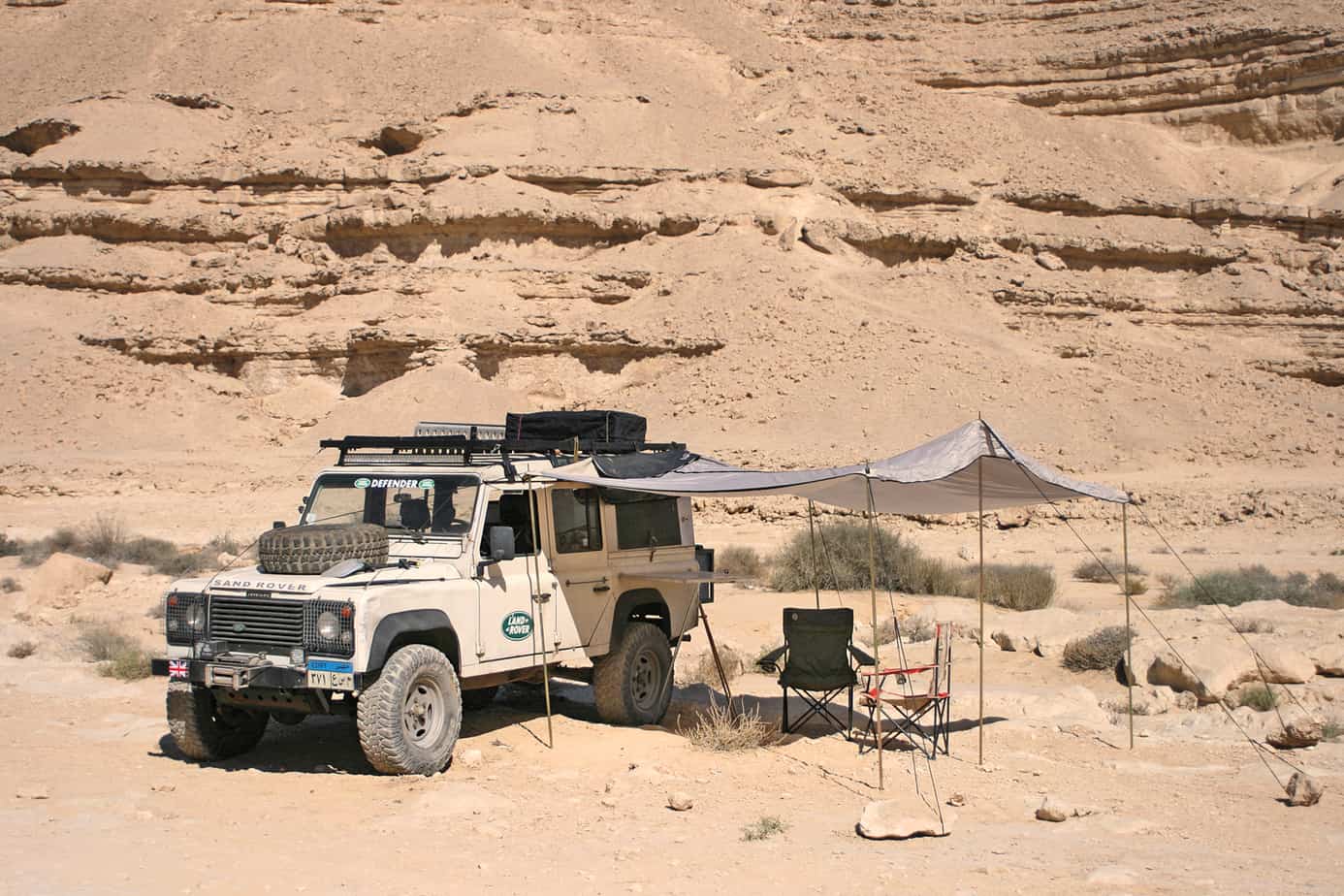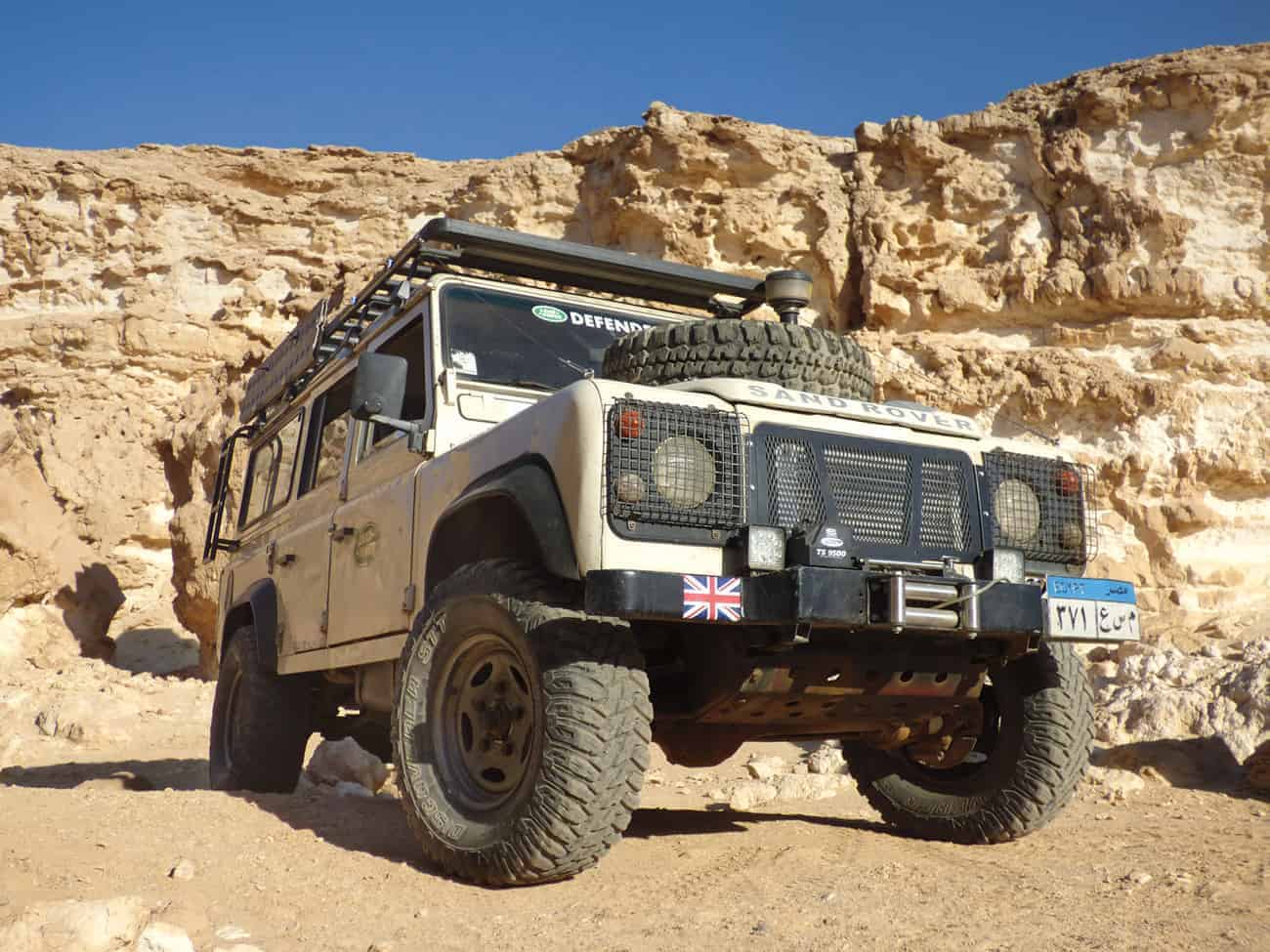Given a clean sheet of paper, how would you go about creating your perfect overland truck? Gather 10 overlanders and you will get 20 different opinions. Everyone has their own ideas and experiences, needs and tasks for vehicles, varied expectations of terrain and difficulties to face, theories on ideal ergonomics, and gut instincts.
I moved to Cairo, Egypt, some years ago with the sole intention of exploring as much of the Sahara and Northeast Africa as I could. I have a well-equipped, overland-spec Land Rover Defender 110 back in Britain, with over 350,000 trouble-free miles on the clock from several African and European trips, but bringing her to Egypt would be a nightmare of idiotic bureaucracy and ridiculous costs. I decided to buy a vehicle in Egypt, despite the fact that used car prices there are perhaps three times what they are in the U.K.; it was still a cheaper option.
So what to buy? The range of available “serious” 4WDs in Cairo is fairly decent, and Toyota Land Cruisers of various types abound. When Britain fell out with Egypt in the ’50s, ’60s, and ’70s, imports of Land Rovers (common across the rest of Saharan Africa) dried to a trickle. The Japanese marketplace was quick to step into the gap, and Toyota is well represented with large numbers of Cruisers and Hiluxes. Close behind in number are Mitsubishi with a range of Monteros. Outnumbering all are Jeeps, but those built in a subsidiary factory in Egypt. Quality control is certainly not up to U.S. standards though. Nonetheless, Cherokees, Liberties, and Wranglers are commonplace.
I wanted a truck capable of remote-area and deep-desert travel. It had to have fuel storage capabilities in excess of 200 litres, turbo-diesel, excellent off-pavement ability, a 1,000(+)-kilogram payload, and a minimal idiocy factor from pointless electronics. It had to be rugged enough to steal the Pearl Eye from the Temple of the Snake God with hat and bullwhip, and reliable enough to bounce rocks off.
It came down to a straight fight between the 70-series Land Cruiser and the Defender 110. Both have proven expedition pedigrees, good turbo-diesels (with Japan’s big four-litre slogger having the edge), both can carry over-the-target payload (here the advantage goes to Land Rover, with a much more favorable payload-to-gross-weight ratio) and both manufacturers have lately fallen prey to increasing electrickery in their engines. So an older vehicle was preferable. Older, simpler, and fixable in the bush. On the trail, Defender has better axle articulation, whilst the Cruiser has more torque and power. So in dunes, the Cruiser has the edge; in mud and rocks, it’s the Defender.
In the end, I fell back on trust and reliability. I’ve owned three Defenders and a Camel Discovery, and all have been turnkey reliable year after year, often in horrendous African conditions. I’ve depended on Defenders as a single vehicle in areas remote from the tarmac, and as far as I could see, the Cruiser wasn’t appreciably better in any significant area, and in fact worse in some—so a Defender it was.
A search turned up a base vehicle: a Defender 110 County Station Wagon, built on Valentine’s Day 1990, imported into Egypt by an oil company for use as a desert survey and exploration truck. She had been retrofitted with a Daihatsu 2.8 turbo-diesel at some stage in her life and was generally in good order. I wasted no time getting into the desert to take her on a test run. All began well, with regular desert expeditions. After a pleasing year or so, however, problems began to occur with the engine. The starter failed. The head gasket blew. The injector pump failed and the car came back on a flatbed into Cairo at the cost of almost $200 USD. The big end bearing went (another flatbed, after being towed out of the desert by another Defender), and the list went on. The head gasket blew again, once more in a remote area. Enough was enough. I decided to take the car off the road for a year or so and rebuild her.
This was no small undertaking, especially in Egypt where Land Rover parts are rare, and competent mechanics are harder to find than dinosaur wool. Shipping parts in from abroad can be horrendous, with port customs authorities known to take items they like the look of, and rapacious shipping companies often charging vast amounts for doing very little. The other side of the coin was that I now had a blank canvas to work from. The truck needed a new engine and suspension, plus the tires and fittings were all looking pretty tired. With labor costs in Egypt being relatively cheap (you do, however, get what you pay for), I had an undreamed-of-chance to build my perfect overland truck for a quite reasonable cost.
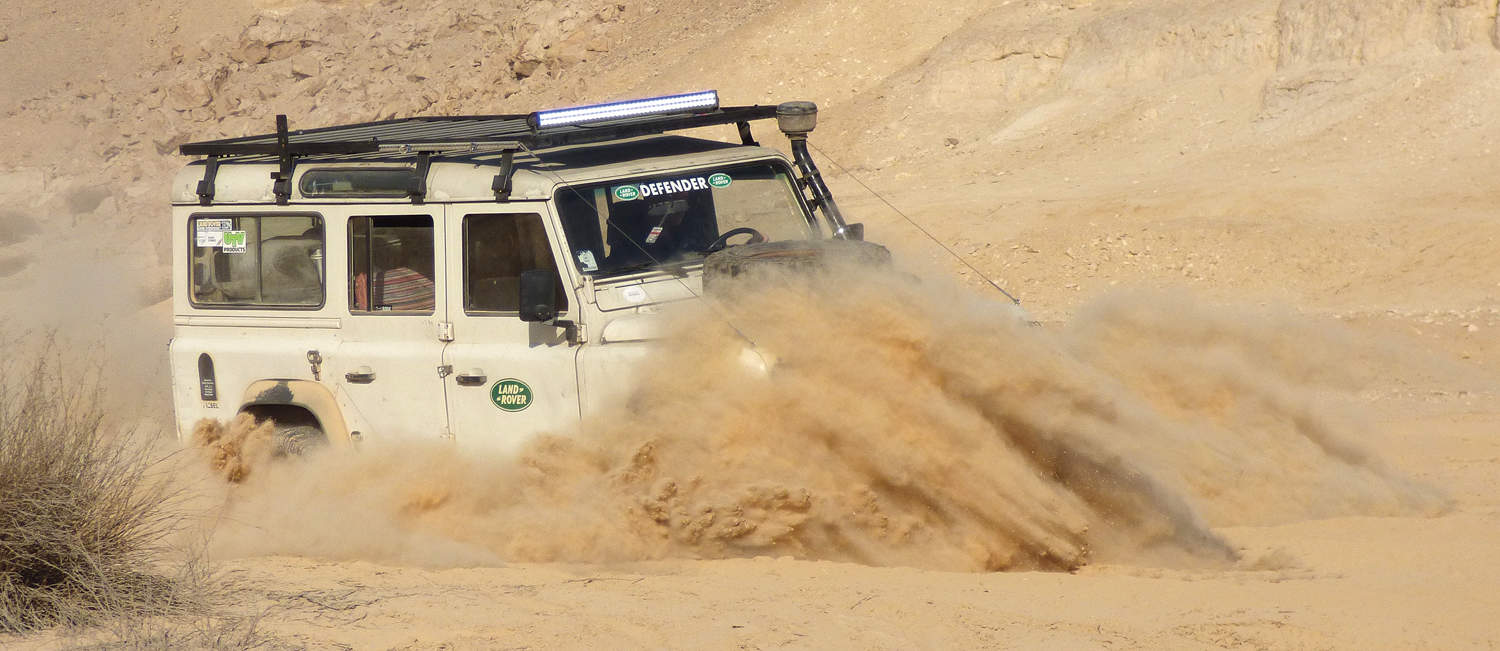
A project set up by a Defender-owning friend whose direction had been changed led me to a rebuilt Land Rover 300Tdi engine. The Tdi, no longer available from the company, is perhaps the best engine Land Rover ever made: a combination of simplicity, reliability and adequate performance. Available in two models, the 200 and 300 series, with some detail differences between them, and produced from 1989 to 2006, the Tdi is a 2.5-litre, 4-cylinder unit producing 111 horsepower and 195 pound-feet of torque. It’s used in the U.S. Army as the power plant for the Ranger Special Operations Vehicle—a modified Defender in war paint used by the 75th Ranger Regiment. In essence, it is a basic, tough, and extremely reliable engine, free of electronic nonsense and easily modified to give better performance.
The 300Tdi was rebuilt with new pistons, a refurbished head, and various other ancillary parts, then topped off with a large intercooler from Alli Sports, bringing power output up to 150 horsepower. The Tdi is a fairly agricultural engine but amenable to all sorts of tuning, and overland specialist mechanic Ben Stowe of Black Paw 4×4 in Yorkshire flew in and tweaked the fuel pump (by now with a Morgan Hill boost pin) to release even more horses into the stable, whilst keeping exhaust gas temperatures sensible. Total power output is now around about a healthy 180 horsepower, with an aftermarket exhaust gas temperature gauge, boost gauge, and capillary water temperature gauge to keep an eye on engine heat in an environment where it regularly soars over a hundred degrees. The engine breathes through a military-spec Mantec snorkel topped by a centrifugal Black Paw prefilter. All engine and transmission breathers have extended breather pipes connected to a neat manifold from Fourby vehicle outfitters, who also supplied the boost pin.
The suspension was the next move. On my U.K.-based Defender, I’d kept suspension components stock for several years, as aftermarket spares have been hard to find throughout Africa. That’s changing now as air freight gets easier, and I started to look at aftermarket kits for the wagon in Egypt, focusing on long life and toughness. Terrafirma proved to be the best option, and their 2-inch commercial heavy-duty setup worked well and is durable under heavy loads.
Much of the terrain the truck operates in is very soft sand, so wider tires spread the mass of the vehicle over a larger surface area. Equally, there is a substantial amount of rock crawling in the Sahara, which argued for a chunky pattern. My first choice was Goodrich All- Terrain’s 235/85R16. However, they proved unobtainable in Cairo at the time. My Defender- owning friends in the city raved about Cooper’s Discoverer STT Pros and a set came up, sized at 285/75R16. On they went, helped by a set of aluminum spacers and mounted on rims from a Land Rover Discovery 1. At 7 inches these are wider than the Defender’s 5.5- inch rims, which are only rated up to 7.50 x 16 inches. After some pretty intense testing I have been very impressed indeed by these monsters. They are augmented by Trailhead deflators and an ARB compressor that serves as an onboard air system.
Aftermarket safari equipment isn’t strictly necessary for overland Defenders, but it makes life a lot easier. My other Defender carries a lot of Front Runner gear: their gas bottle bracket, storage drawer/box system, and stashable Safari table. I’ve been pleased with their performance, so it was to Front Runner I turned to equip this desert-dwelling beast, supplied again by Black Paw 4×4, who are well-versed in shipping overland equipment to strange places on short notice. Front Runner’s Slimline II aluminum roof rack combines lightness and toughness, so that went on, along with an awning from the same company. A custom rear spare wheel carrier with integral twin jerry can rack and Hi-Lift mount, large locker to replace one of the rear windows, and a set of Fourby brush wires to protect the windshield from overhanging branches appeared on what was now a purposeful-looking truck.

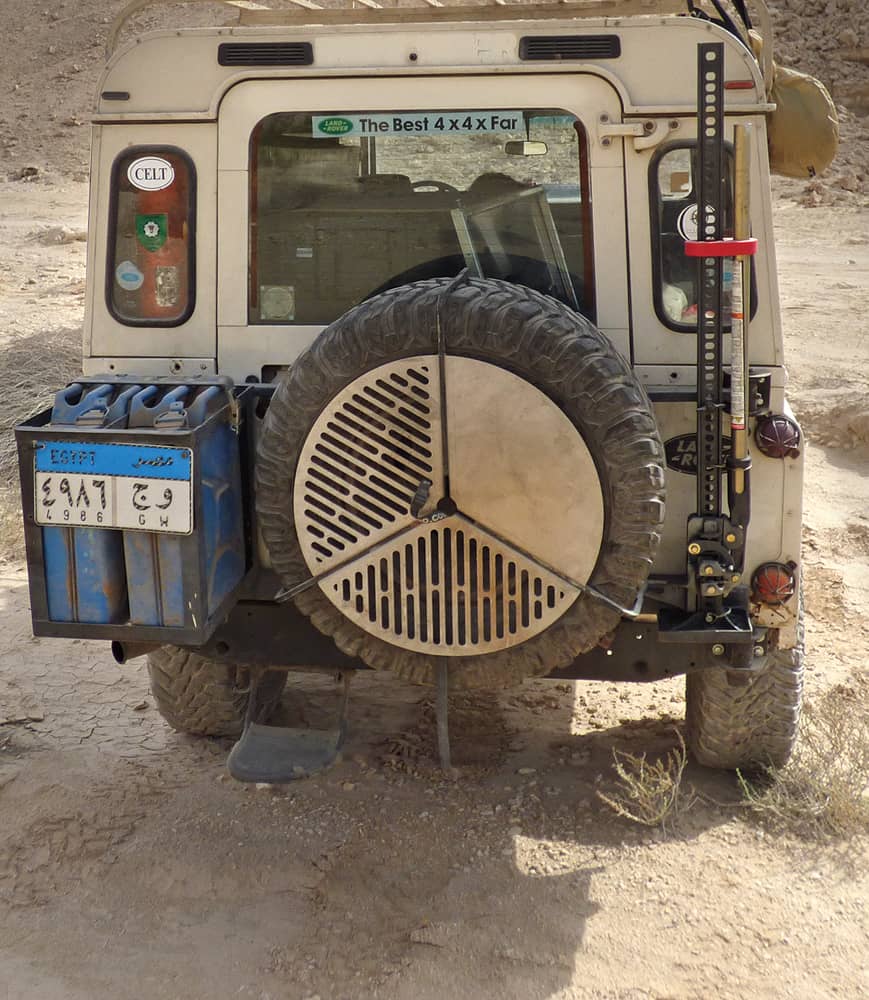
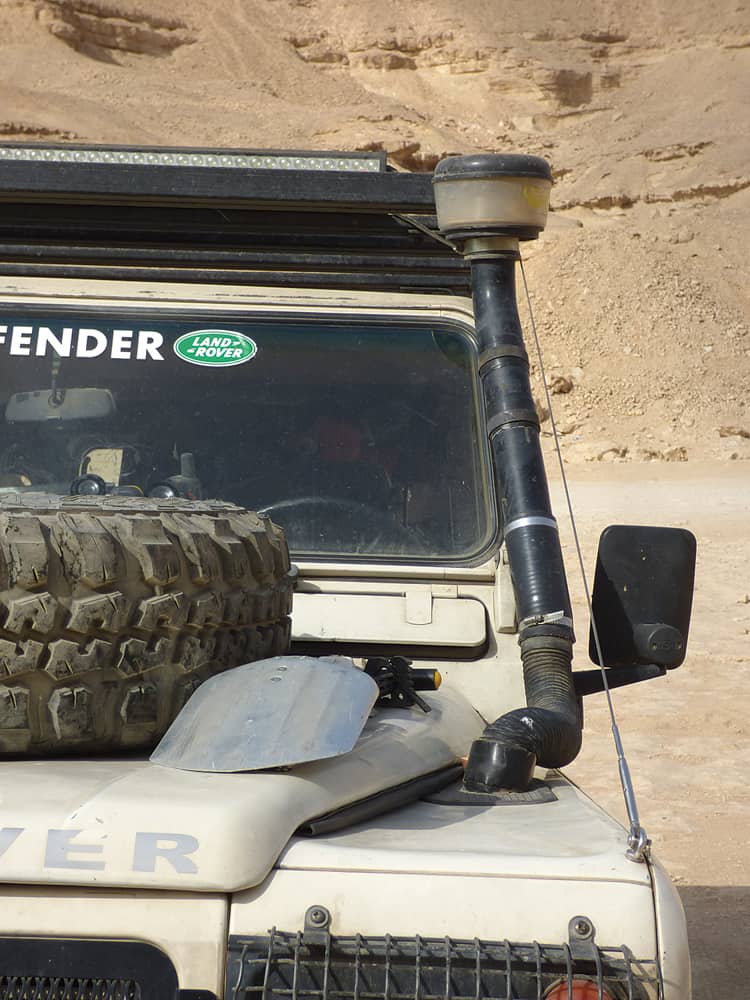
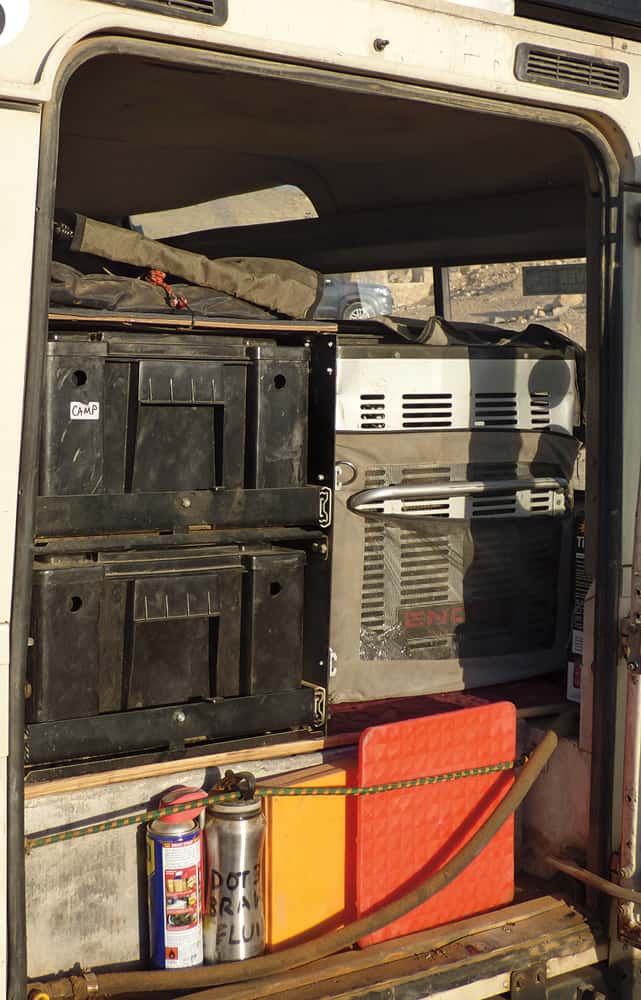
I’ve long been keen on the South African military’s Wolf ammunition boxes. They are made of strong recycled plastic and are tough, stackable and waterproof—excellent for storage either inside the vehicle or strapped to the roof rack. Front Runner makes a capable Wolf Pack drawer system to store them, so you have the utility of a storage drawer system and yet can remove the drawer and carry it through camp to where it’s needed. So added to the refit went a four-box storage drawer unit containing camp kit, kitchen and BBQ gear, tools, and personal items. This went into the rear load bay of the Defender, sitting neatly on top of a custom-made, 220-litre aluminum diesel tank to augment the existing standard 80-litre tank and a 40-litre underseat auxiliary tank. All in all, this gives an unrefueled range of over a thousand off-pavement miles—enough for a desert trip that might go into the Sudan or Libya.
Recovery gear is, of course, important— ideally for self-recovery, both in the desert and in sub-Saharan Africa to the south. The latter is important as the beast is heading on the Cairo to Cape Town route before long, and it’s not just sand she will need to cope with. So a winch was important. My preference is for electric winches, so a Superwinch Tiger Shark 9500 arrived by air freight, together with various military air bag jacks, strops, and shackles. Aluminum sand ladders have a bracket on the roof rack.
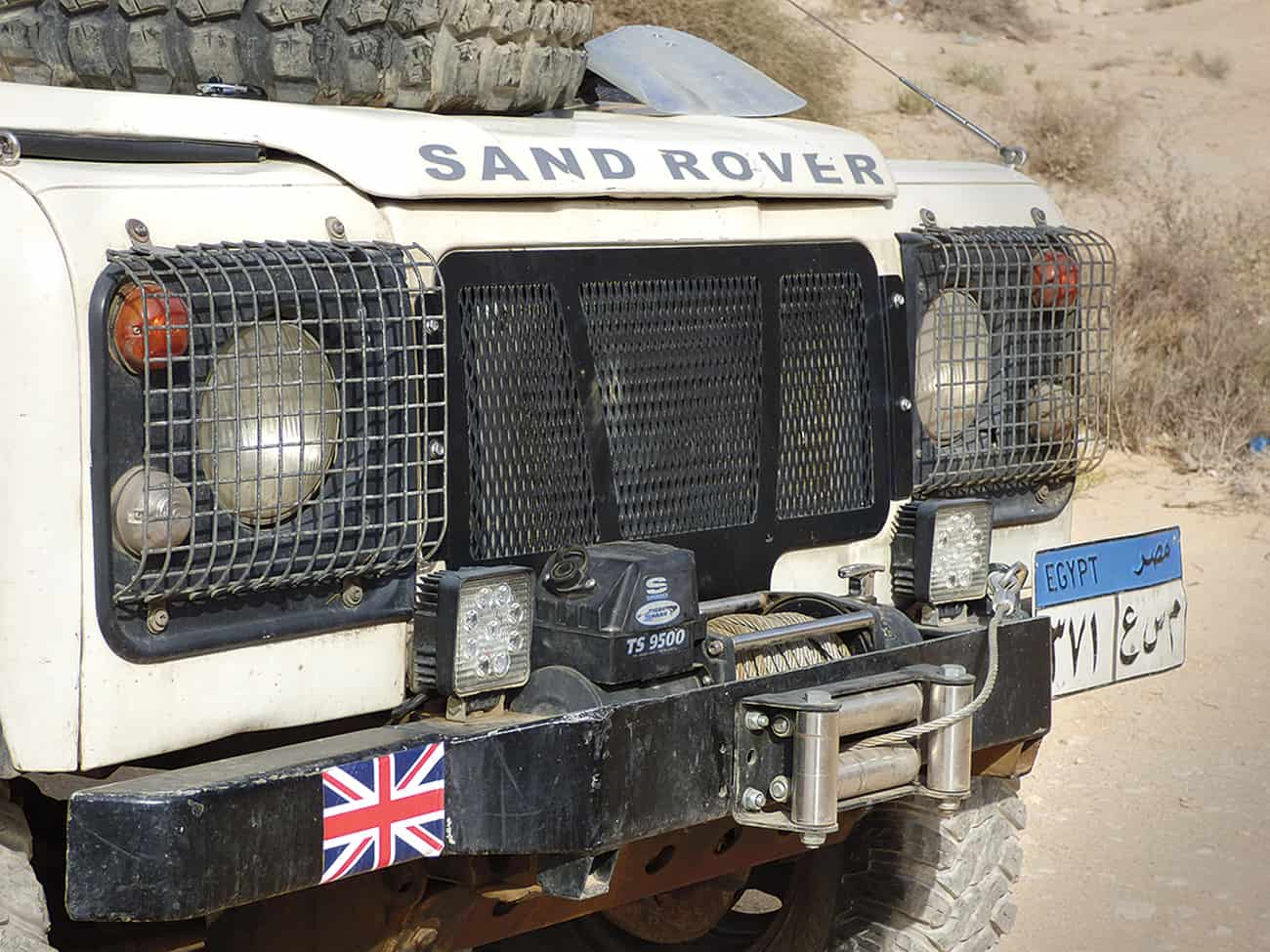
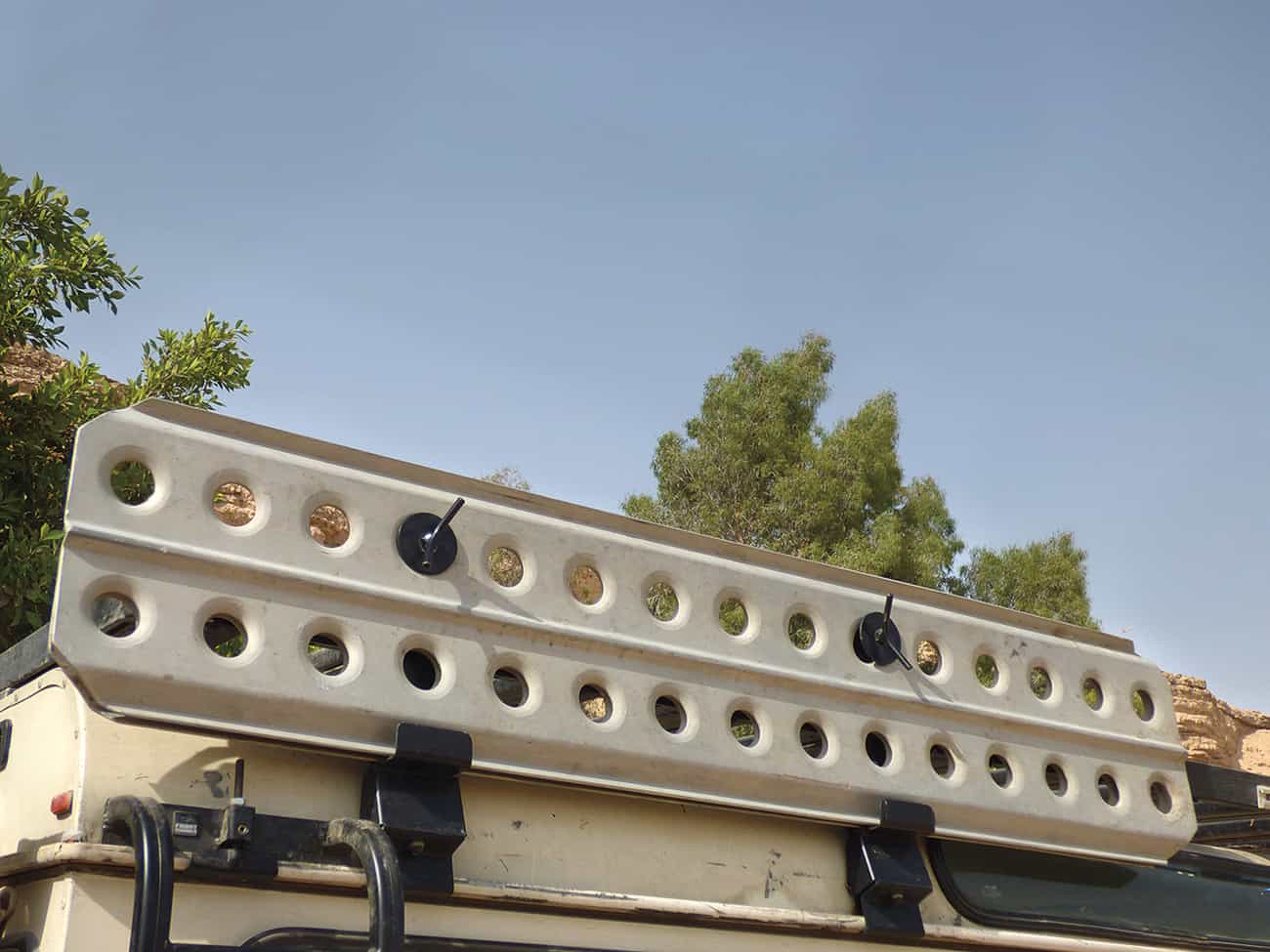
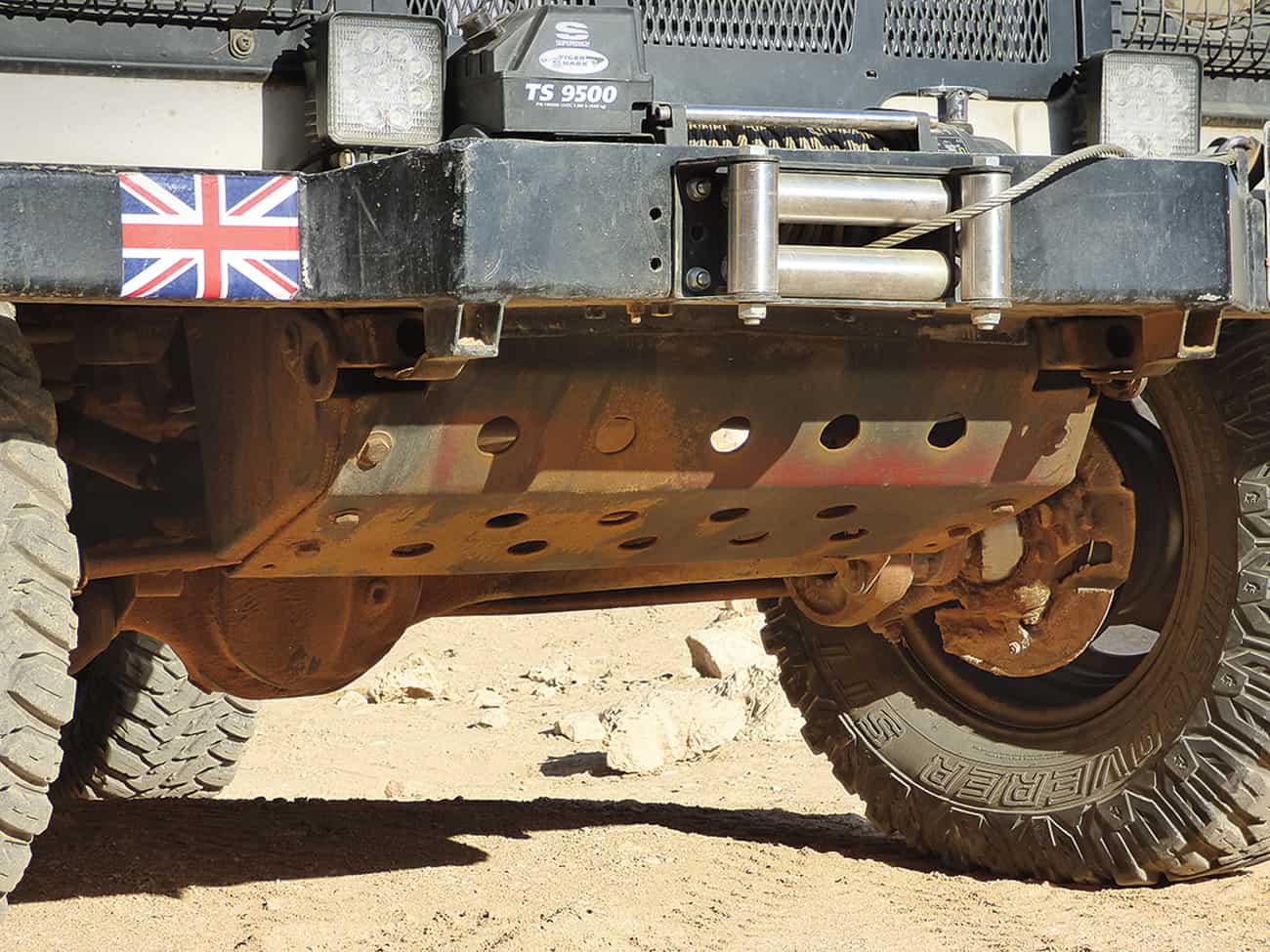
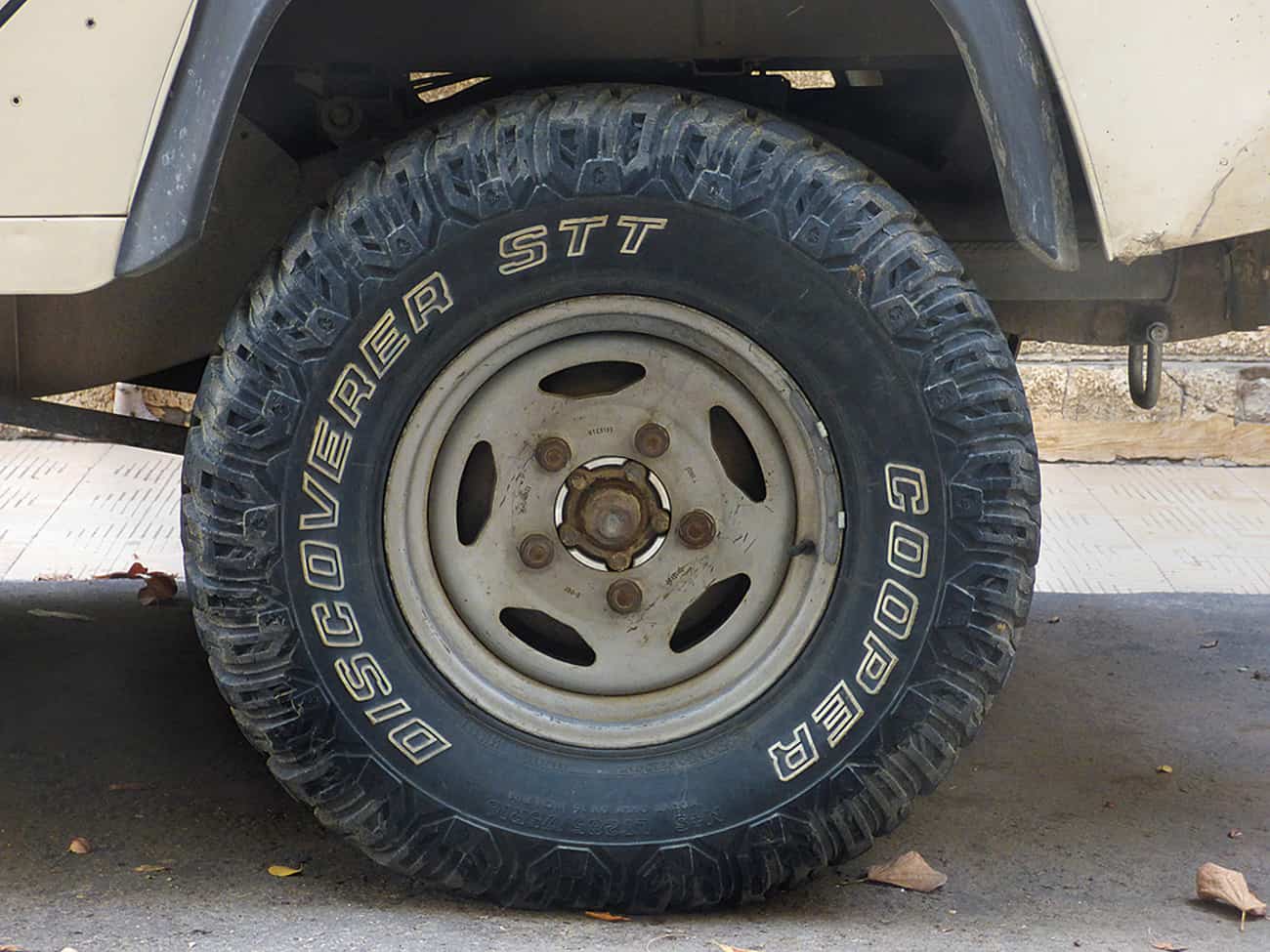
The lighting system also needed attention. In North Africa, local drivers tend to drive at night with either no lights at all, or all lights maxed out at full beam. Where tarmac roads exist they are often totally unmarked and with rough, loose edges. Ranged against this were the standard Defender headlamps, so LED lighting systems from UTV Products were an obvious addition. Two floods for the nose and a light bar for the front of the roof rack ensure that the flock of unlit goats in the highway ahead (plus goatherd) are saved from their destiny as instant kebab.
Obtaining kit has often been problematic and fitting it is not without incident. When the Tdi was first plumbed in, the local mechanic installed it so that fuel ran from tank-water-separator-filter-lift pump-injector pump, rather than the more suitable fuel-tank-lift pump-separator-filter-injector-pump. So on her first serious trial trip, the injector pump destroyed the lift pump. Having traced the problem I replumbed the fuel system, adding an extra filter to cope with the horrendous quality of local diesel (easily the worst in Africa). I then tied the mechanic down in the sun, covered in honey, and staked him over an anthill. The exhaust system has been welded up and “created” by a local specialist known as Mahmoud the Muffler. It rattles a bit but is otherwise effective.
There have also been electrical issues. The standard wiring had been locally bodged so many times before I bought the beast that the wiring loom looked like something usually served with tomato sauce and meatballs, with a side order of duct tape, so a local electrician rewired her. Predictably this came with attendant chaos: the wire taking current to the starter was too thin to handle the load in high temperatures, which meant that when the engine was hot and the ignition was turned off, she wouldn’t restart. Investigation followed. By now the anthill was getting crowded.
The guts for the onboard electrics comes from twin Odyssey batteries and a splitcharge monitoring system from National Luna. Fourby provided a neat twin marine socket plus a USB socket unit for the dash that provides power for twin Garmin GPSs—a Montana and a GPSMAP 62s. Twin units because after an older unit of mine failed 20 years ago, wiping waypoints next to an Algerian minefield, I prefer belt and braces! Also from Fourby is an engine heat exchanger system that provides hot water for showers, together with other creature comforts like an 80-litre Engel fridge for essentials like tonic water and lemons.
After an 18-month rebuild, I have a truck that far exceeds all my expectations. Powerful, able, and reliable, the Defender (named Stella after an Egyptian beer) will easily last another 25 years of wild trails before her next major visit to the vet. On an early test trip, she recovered a large bus that some clown had driven into the soft Saharan sand, barely breaking a sweat in the process, and continues to impress with her solid, unpretentious capability. The final ingredient will be a roof tent from My- Way, as tried and tested on my other Landy. All that really needs to be added though are open skies—something Africa has plenty of. Now, bring on that horizon.
